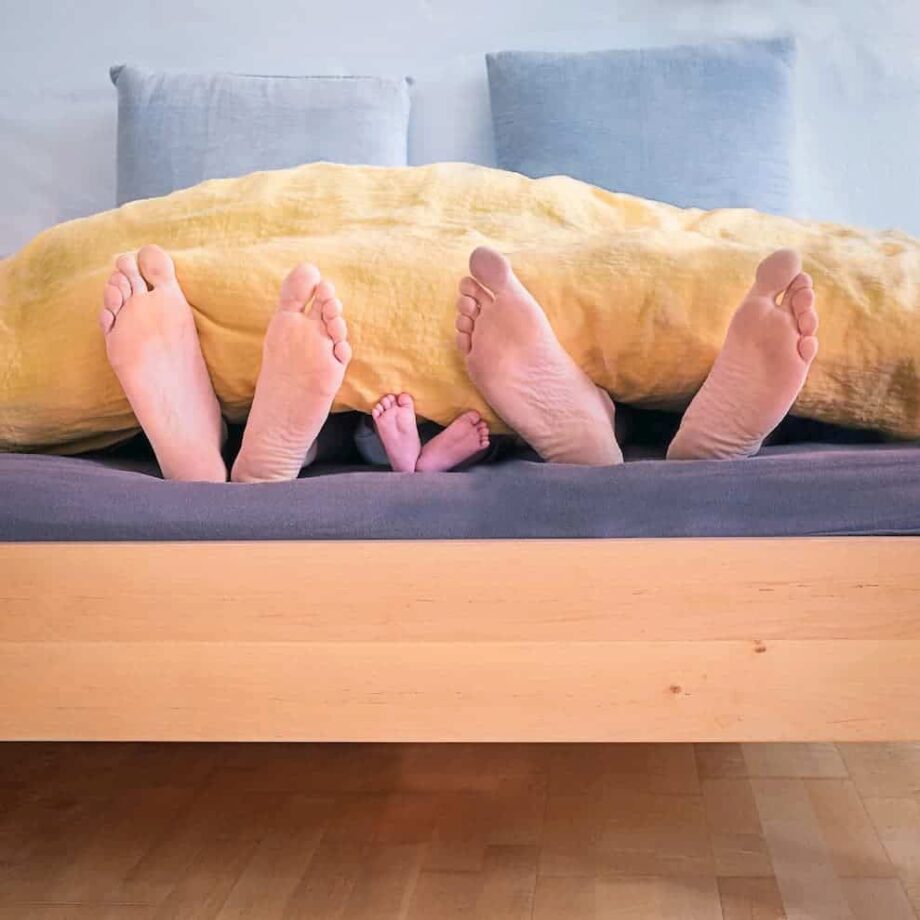Guide to CoSleeping and Bed Sharing
Disclosure: By clicking on the product links in this article, Mattress Nerd may receive a commission fee at no cost to you, the reader. Read full disclosure statement.
What is Cosleeping?
Cosleeping is the act of sleeping close to your baby. The term originally meant sleeping in the same bed as your baby, but it has since been broadened to include sleeping in the same room. Sleeping near your baby sounds like a natural practice, anthropologists suggest that humans have been doing so for hundreds of thousands of years. However, like most things in life, whether or not your baby sleeps in your bed at night can be a complex decision.
The American Academy of Pediatrics strongly recommends against sharing a bed with an infant for a variety of reasons. Since this practice is so strongly advised against, parents are often afraid to discuss the issue with their pediatrician, missing the opportunity to learn the safety measures that are important to take. It is important to have open and honest conversations about cosleeping and how we can keep our babies safe.

Why Would Anyone Oppose Bed Sharing?
If you are a parent or have cared for a newborn, you have likely heard of sudden infant death syndrome (SIDS). While the exact reason for SIDS is unknown, there are a variety of factors that can put a baby at a higher risk. Some of these factors include; babies born prematurely or having a low birth weight. A baby born to a very young mother can increase the risk, as well as if the mother drinks alcohol or smokes during her pregnancy.
If your baby is considered “low-risk” for SIDS, the chances of something unthinkable happening while sleeping in a parent’s bed is slim to none. However, the chances of a high-risk baby dying under the same circumstances are more than 100 times higher than those of a low-risk baby.
Statistics from the CDC indicate that there were about 3,600 unexpected deaths of infants in the US in 2017. Nearly 40% of those were due to SIDS, while about one-quarter of the deaths were due to accidental suffocation in bed. While the number of deaths due to SIDS has been falling, the number of deaths from accidental suffocation and strangulation increased 1.8 times between 1999 and 2015. The number of babies sharing a bed with an adult doubled from 1993 to 2010.
How to Keep Your Baby Safe at Night
These statistics can be alarming, but there are many steps that parents and caretakers can take to increase their baby’s safety at night. No matter where your baby sleeps, there are certain sleeping practices you should always use. Always lay your baby on their back when in bed or breastfeeding. When a baby is on their stomach they may not be able to move their head if they are unable to breathe.
Another caution is to never leave pillows, soft blankets, toys, or stuffed animals near your baby while they are sleeping. These soft objects could accidentally suffocate the infant. Avoid soft bedding and always use a firm mattress. Do not put your baby on a waterbed, beanbag, pillow, or sheepskin. Additionally, never put a baby on a sofa or recliner to sleep where they could get wedged against the back or fall into a crevice.
RELATED: Best Crib Mattresses
Advantages of Cosleeping & Room Sharing
Room sharing offers many of the same benefits of bed-sharing without the risk. In this case, your baby sleeps in a crib or bassinet close to your bed. There are even cribs that open up on one side, so you can easily touch your baby at night. Sleeping arrangements such as these enable you to closely attend to your baby without the risks of accidental suffocation. You are more likely to get a good night’s sleep, and this is usually true for your baby as well. When your baby starts to wake up, you can quickly comfort them since they are so close to you. Additionally, your baby will not get anxious about being separated at night when they have their parents sleeping next to them.
If you sleep in the same room, you reduce the risk of SIDS by as much as 50% according to the American Academy of Pediatrics, which strongly recommends room sharing. The Academy recommends that you continue this sleeping mode at least until your baby is six months to a year old.
Attachment Parenting and Cosleeping
Fortunately, times have changed, and no longer is sleeping next to your baby considered to be something shocking that should be kept hidden from a disapproving society. Cosleeping fits marvelously into the framework of attachment parenting advocated by Dr. William Sears. Sleeping together and being touched at night helps infants to develop a trusting attachment to their parents. In addition to improving the quality of life for parents and infants, sleeping next to your baby could help save their life!


